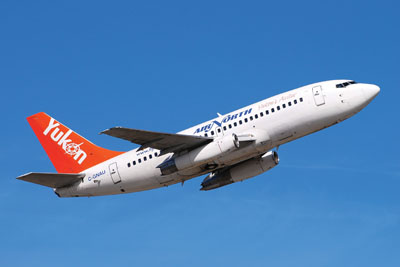
Features
Operations
At The Gate: The capacity question
There are more than 100 airlines in Canada, large and small, offering passenger, charter and/or cargo service, but only a handful that serve Canada’s north. The major regionals serving the area include Air North, First Air and Canadian North.
May 13, 2010 By Brian Dunn
There are more than 100 airlines in Canada, large and small, offering passenger, charter and/or cargo service, but only a handful that serve Canada’s north. The major regionals serving the area include Air North, First Air and Canadian North.
 |
|
That’s still a lot of capacity for a thinly populated region of the country, especially when you consider there are a number of smaller operators serving some of the same routes. So, Whitehorse-based Air North wasn’t too pleased when Air Canada expanded capacity by more than 40 per cent in a declining market last summer and started selling seats below cost, according to Joe Sparling, Air North’s president and CEO.
He sees a bit of a parallel between the situation in the north and Air Canada’s attempt to block Emirates Airlines from increasing frequencies to Canada. Air Canada claims there is already more than enough capacity to carry all the people who want to travel between Canada and the United Arab Emirates.
Sparling believes there is more than enough capacity to carry people who want to travel between the north and south.
“While there will always be mainline competitors, I would like to see them manage their capacity better. Their (increased) presence here is driven by the economic conditions in the southern markets, which has created difficult market conditions in the north.”
That sentiment is echoed by Scott Bateman, president and CEO of Kanata, Ont.-based First Air, who believes both Air Canada and WestJet are increasing capacity in the north to offset tougher economic conditions in the south.
“If I were an Air Canada shareholder, I’d be scratching my head. There’s no rationale why they should be flying into our market. WestJet has also moved into the market.”
Bateman adds it’s a repeat of former Canadian Airlines International and Air Canada beating each other up for market share before Air Canada acquired its rival in 2001. The only difference is WestJet has replaced Canadian, with the northern carriers ending up as collateral damage.
He estimates the Edmonton-Yellowknife route is 300 per cent over capacity and Calgary-Yellowknife not much better, which has had a huge impact on First Air’s bottom line.
While he admits the presence of the mainline carriers has stimulated the market and load factors are up, it’s hard to make money with tickets priced at between $49 and $125.
“If we can’t compete with the mainline carriers on the major routes, we’ll have to move operations further north to our hubs.”
Bateman also took a swipe at Canadian North of Yellowknife which, on the one hand, lambasted Air Canada for launching service on the “overcrowded” Iqaluit, Ottawa and Montreal route, then agreed to provide baggage-handling and ticket-counter service to its rival.
“Why would you support a southern carrier when they will be taking money out of your pocket?”
The move was defended by Canadian North president Tracy Medve, who said ground handling was only part of the equation.
“We also entered into a commercial agreement with Air Canada by putting our code on some of their flights, which lowers the fare on some routes by offering a through fare. For example, someone flying from Pond Inlet (Nunavut) to Toronto will see a single fare and we also get access to Air Canada lounges.”
The market has improved since last year, according to Sparling, Bateman and Medve, with traffic starting to return to normal.
“We weren’t as badly impacted as the south because the territorial government had several capital projects going and the mining industry also kept us busy,” says Sparling.
Both First Air and Canadian North were badly hurt by a decline in mining and oil and gas exploration activity, which have since begun to pick up.
Canada’s airline industry as a whole is expected to eek out a modest profit this year, but will remain well below pre-recession levels, according to a report by the Conference Board of Canada.
Although earnings and revenue will climb steadily over the next four years, it won’t be until 2014 that profits surpass the recent high of $505 million in 2007, according to the board.
Brian Dunn is a Wings writer and columnist.
Print this page